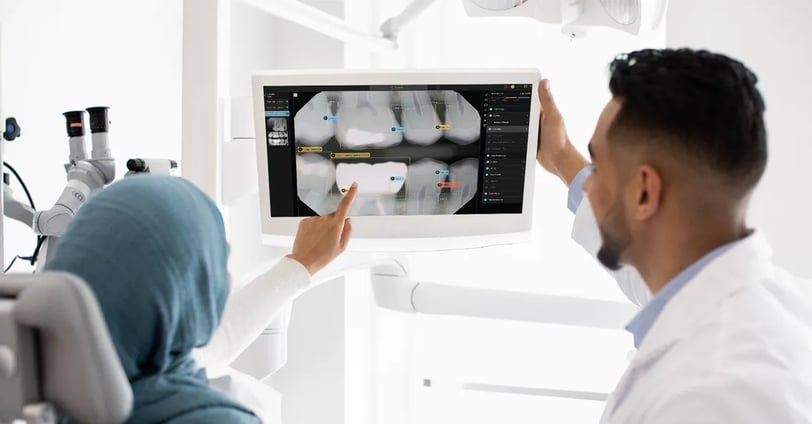AI-Powered X-Ray Analysis for Improving Dental Imaging
Dental imaging plays a crucial role in diagnosing and treating oral health issues. X-rays, in particular, have been a fundamental tool for detecting cavities, gum diseases, infections, and structural abnormalities in teeth and bones. However, traditional X-ray analysis is not immune to human error and can sometimes miss subtle signs of dental problems. This is where AI-powered X-ray analysis is stepping in to revolutionize dental care, providing faster, more accurate, and reliable results for both dentists and patients.
2/28/20254 min read


The Role of Dental X-Rays in Oral Health
Dental X-rays are essential in uncovering problems that are not immediately visible to the naked eye, such as:
Cavities between teeth
Bone loss due to periodontal disease
Abscesses and infections
Impacted teeth
TMJ disorders
Traditionally, these X-rays are evaluated by dental professionals, who interpret the images to identify any issues. However, interpreting X-rays can be time-consuming, and even experienced professionals may miss subtle signs of disease or abnormalities, leading to delays in treatment and patient outcomes.
How AI is Transforming Dental X-Ray Analysis
Artificial intelligence (AI) has revolutionized various sectors, and dentistry is no exception. AI-powered tools are now being used to assist dental professionals in analyzing X-rays with greater accuracy, speed, and efficiency. Here's how AI is enhancing dental imaging:
1. Improved Accuracy and Detection of Dental Issues
AI systems are trained to recognize specific patterns and anomalies in X-ray images. Deep learning, a subset of AI, enables these systems to analyze thousands of dental X-rays and learn how to spot early signs of dental issues that may be difficult for human eyes to detect. For example, AI can detect:
Early-stage cavities: Small cavities between teeth that may be hard to spot with the naked eye.
Periodontal disease: Bone loss or changes in bone density due to gum disease.
Root infections: AI can help identify infections in the root of the tooth, which can be invisible to the naked eye.
Oral cancers: Early signs of cancerous lesions or tumors in the mouth can be flagged by AI systems, enabling earlier intervention.
AI doesn’t just match human interpretation—it can surpass it by identifying subtle patterns that may be overlooked in traditional diagnoses.
2. Enhanced Efficiency and Speed in Diagnosis
AI algorithms can process and analyze dental X-rays in a fraction of the time it would take a human. This speed can greatly benefit dental practices, especially those with a high patient volume, by allowing dental professionals to quickly review multiple X-rays and make timely diagnoses. AI can also help prioritize cases that require urgent attention, allowing dentists to focus on more complex or severe conditions.
For example, AI systems can instantly identify a cavity or root infection in an X-ray, and bring it to the dentist’s attention in real-time, allowing for quicker treatment plans and more efficient patient care.
3. Reducing Human Error in Dental X-Ray Interpretation
Human error is an unavoidable factor in any profession, and dentistry is no exception. Even the most experienced dentists may miss subtle signs of disease or overlook issues in X-rays due to fatigue or the complexity of the images. AI-powered dental X-ray tools can reduce this risk by offering a second opinion, assisting dentists in making more accurate diagnoses.
AI also helps reduce the risk of oversight when interpreting X-rays from a variety of angles or with different levels of image quality. If the X-ray is of poor quality, AI systems are capable of enhancing the image or detecting problems even when the image is not clear to the human eye.
4. Enhancing Early Detection and Preventive Care
One of the most significant benefits of AI in dental imaging is its ability to enhance early detection. The sooner a dental issue is diagnosed, the easier it is to treat, and the better the patient’s overall oral health will be. With AI’s ability to detect even the most minute changes in dental X-rays, it helps identify potential issues in the earliest stages, even before the patient might experience symptoms.
For example, AI can detect early signs of periodontal disease before the patient notices any discomfort, leading to timely intervention and better outcomes. Similarly, it can spot hidden cavities that may not cause immediate pain but could worsen over time.
5. Better Patient Communication and Treatment Planning
AI-powered dental X-ray analysis also allows for better communication between dentists and their patients. By using AI systems to highlight and explain issues in the X-rays, dentists can clearly show patients the areas of concern and educate them about their oral health. This transparency helps patients understand their condition better and feel more comfortable with the proposed treatment plan.
Additionally, AI can assist in treatment planning by offering suggestions based on the detected issues, helping the dentist choose the best course of action. Whether it’s recommending a root canal for an infection or scaling and root planing for gum disease, AI ensures that the treatment plan is aligned with the precise diagnosis.
Case Studies of AI in Dental Imaging
Early Detection of Cavities: AI tools like Voxelscan have been trained on a vast database of dental X-rays to detect early-stage cavities. These tools have been proven to identify cavities in areas that may be missed by radiologists or dentists, leading to earlier intervention and more effective treatment.
AI for Periodontal Disease Detection: Tools like Overjet use AI to analyze dental X-rays and detect signs of periodontal disease, even in its early stages. This helps dentists identify bone loss before it becomes visible during a regular exam, allowing for quicker treatment to prevent further damage.
Oral Cancer Detection: AI-based systems like RadAI are helping detect early signs of oral cancers through X-rays, identifying potentially malignant lesions or irregularities that may be hard to spot. Early detection of cancer increases the chances of successful treatment and recovery.
The Future of AI in Dental Imaging
AI’s role in dental imaging is still evolving, but the future looks promising. As AI algorithms continue to advance, they will become even more accurate, capable of identifying even more complex conditions and improving diagnostic precision. Additionally, AI will continue to assist in teledentistry, enabling remote diagnosis and consultations, which is especially helpful in areas with limited access to dental care.
As AI continues to learn from vast datasets and improve its algorithms, it is expected that dental X-ray systems will become an indispensable tool in improving patient outcomes, making dental care more precise, faster, and accessible.


Reference Website Link:
Dental Tribune International
Overjet - AI in Dentistry
Voxelscan
Dental Economics - AI in Dentistry
Zebra Medical Vision
Ada Health
AI in Health
Innovative
Contact Us
Service
xraybazar.com
© 2024. All rights reserved.
Address- Rajasthan, India
Gmail Id- xraybazaroffcial.com
Important Links
